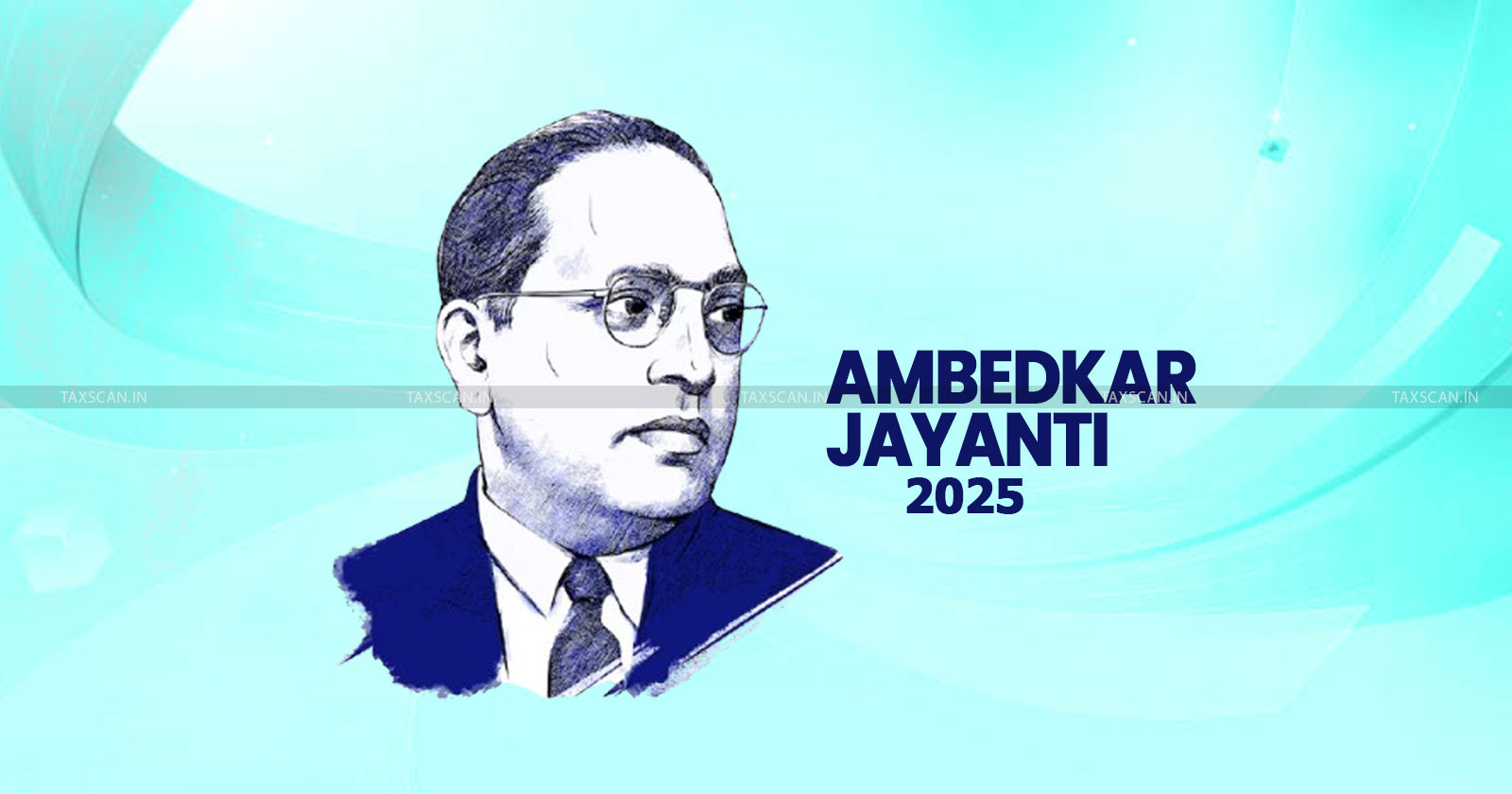Ambedkar Jayanti 2025: His Economic Vision vs. India’s Fiscal Reality Today
Ambedkar’s vision of a just, state-led economy remains only partly fulfilled in India’s 2025 mixed-market reality

Ambedkar Jayanti 2025 – Dr Ambedkar economic vision – Ambedkar and Indian economy – TAXSCAN
Ambedkar Jayanti 2025 – Dr Ambedkar economic vision – Ambedkar and Indian economy – TAXSCAN
“On the 26th of January 1950, we are going to enter into a life of contradictions... In our social and economic life, we shall... continue to deny the principle of one man one value.”
— Dr. B.R. Ambedkar, November 25, 1949
As India celebrates the 134th birth anniversary of Dr. B.R. Ambedkar, it must do more than pay ceremonial tribute—it must pause and reflect. The democratic framework he so carefully drafted has taken root politically, granting every citizen a voice and a vote. Yet, the economic structure of the nation remains entangled in inequality, echoing the very contradictions Ambedkar warned against.
Seventy-five years after the adoption of the Constitution, the gap between political equality and economic justice persists. On this Ambedkar Jayanti, we revisit his economic ideals not as a historical footnote, but as a living standard, and examine how far India’s fiscal and social policies in 2025 align with his vision for a just, inclusive, and equal society.
Become PF & ESIC Pro: Basic to Advance Course - Enroll Today
Read More: New ISD Rules Effective April 2025: How Debit and Credit Notes Affect ITC Distribution
Key Elements of His Economic Ideas:
Government Ownership of Major Industries: Ambedkar wanted essential industries such as mining, transport, and heavy manufacturing to be run by the government, not private companies. He argued this would prevent wealth concentration and ensure fair use of resources. In a submission to the Constituent Assembly, he clearly stated that economic planning and state control were necessary to avoid exploitation.
Agriculture as a Government Responsibility: He believed farming should be treated like an industry, owned and operated by the state. He supported collective farming, where landless laborers—often from lower castes—could work together and share benefits. He believed this would reduce rural poverty and break caste-based land monopolies.
Focus on Equality and Justice: Ambedkar promoted affirmative action (reservations), land redistribution, and other strong reforms to bring economic justice to the poor and marginalized. He believed in positive government action, not just neutrality, to fix deep-rooted inequalities.
Education as a Path to Empowerment: He saw education as the most powerful tool to change lives. Empowering the oppressed through learning was central to his economic thinking.
Critique of Rural and Village Life: Unlike Gandhi, who celebrated villages, Ambedkar saw them as places where caste discrimination thrived. He believed that only industrial development and urbanization could break caste barriers and lead to real economic progress.
Ambedkar’s vision was not just about making the economy grow—it was about using the economy as a tool to build a fair, just, and equal society.
Read More: India and 62 Countries Support Global Carbon Tax to Cut Shipping Emissions
Plead Your IT Appeals Effectively Using AI, Click Here
India’s Fiscal Reality in 2025: A Mixed Economy Approach
As of April 2025, India operates under a mixed economic model, combining government policies with a large and active private sector. The focus is on infrastructure growth, fiscal discipline, and targeted welfare programs.
Key Highlights:
- Fiscal Deficit Target: The government plans to reduce its fiscal deficit (the gap between income and spending) to 4.4% of GDP in 2025-26, down from 4.8% in 2024-25.
- Capital Investment: Government spending on roads, railways, housing, and other projects is set to increase by 11.1%, reaching Rs. 11.11 trillion ($134 billion). This is meant to stimulate economic activity, especially in rural and semi-urban areas.
- Economic Growth Projections: India’s economy is expected to grow between 6.3% to 6.8%, according to the Economic Survey 2024-25. However, this growth is not seen as transformative enough to change structural inequalities.
- Tax Revenue: Government revenue from taxes is expected to rise by over 11%, reaching Rs. 38.31 trillion ($462 billion), helping maintain financial stability.
Taxation Philosophy: Equity vs. Consumption
Ambedkar’s Perspective:
- Progressive Taxation: Advocated for taxes based on an individual's capacity to pay, ensuring the wealthy contribute a fairer share.
- Critique of Indirect Taxes: Opposed regressive taxes like the salt tax, which disproportionately burdened the poor.
- Land Revenue System: Criticized the colonial land tax system for its inequitable impact on peasants and small farmers.
India in 2025:
- Income Tax Reforms: The Union Budget 2025 introduced a zero-tax threshold for incomes up to Rs. 12 lakh, aiming to boost disposable income among the middle class.
- Indirect Taxation: Despite reforms, India's tax structure remains heavily reliant on indirect taxes like GST, which can be regressive and affect lower-income groups more significantly.
Analysis: Steps have been taken to alleviate tax burdens on the middle class, but the continued emphasis on indirect taxation contrasts with Ambedkar's vision of a more equitable, capacity-based tax system.
Read More: No More Exemptions: UK Residents with Indian Domicile to Face Tax on Foreign Income from April 2025
Policies for Marginalized Communities in 2025
India has introduced several schemes aimed at helping the poor and socially disadvantaged groups:
- Direct Benefit Transfers (DBT): Rs. 22.6 lakh crore (about $271 billion) has been directly transferred to citizens' bank accounts under various welfare schemes. This reduces corruption and ensures the money reaches the intended beneficiaries.
- Reservations: Besides existing quotas for Scheduled Castes (SC), Scheduled Tribes (ST), and Other Backward Classes (OBC), a 10% reservation for economically weaker sections (EWS) in the general category has been introduced.
- Rural Prosperity Program: A new initiative focuses on empowering rural women, landless farmers, and youth by investing in skills, technology, and infrastructure.
- Digital Inclusion: Through the Digital India program, efforts are being made to bring internet, digital payments, and online services to villages—helping bridge the rural-urban divide.
Yet, challenges remain. Studies show that social groups like SCs, STs, and Muslims continue to have lower life expectancy, limited access to justice, and fewer economic opportunities. Inequality, though tackled on paper, still runs deep.
Ambedkar vs. 2025: Where Do They Meet?
| Aspect | Ambedkar’s Vision | India 2025 | Result |
| Economic Structure | State socialism | Mixed economy with private dominance | Divergence |
| Agriculture | Collective farming, state industry | Privately owned, government-supported | Divergence |
| Industrialization | Government-led | Public-private partnerships in infrastructure | Partial Alignment |
| Social Justice | Land reform, affirmative action | DBT, reservations, rural programs | Partial Alignment |
| Education & Empowerment | Universal access, equity | Reservation-based access, quality gaps | Partial Alignment |
Conclusion: Bridging Two Realities
Ambedkar dreamed of a deeply transformative and equal society. He wanted not just better laws but an economy that actively worked to uplift the downtrodden. India in 2025 has made progress, especially in digital outreach, infrastructure, and financial inclusion. But the country still follows a market-based, moderate model, not the bold state-led restructuring Ambedkar had envisioned.
To truly fulfill his legacy, India must move beyond symbolic gestures and election-driven welfare, and commit to policies that challenge inequality at its root—through land reforms, quality education, and full economic inclusion.
Support our journalism by subscribing to Taxscan premium. Follow us on Telegram for quick updates


